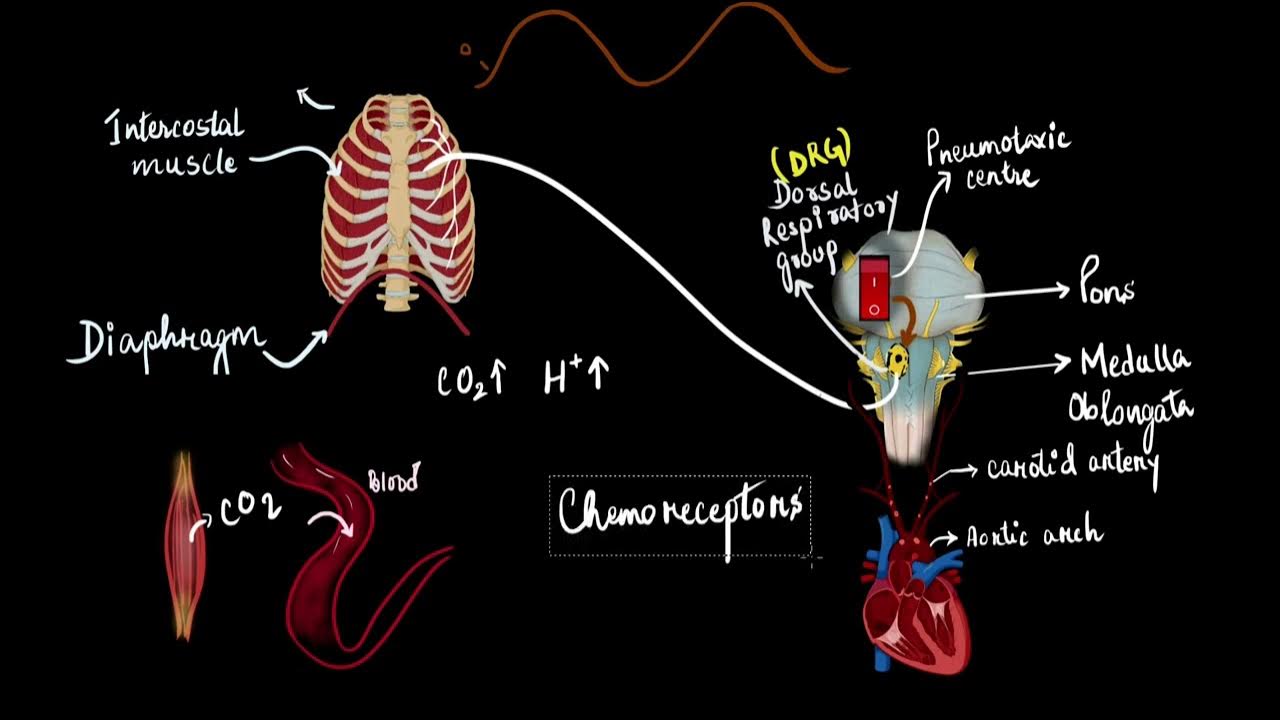Neural Control of Breathing | Respiratory System
Summary
TLDRThis video explains the neural regulation of breathing, detailing how the brain controls respiratory rate. It covers the mechanics of lung function, including pressure and volume changes during breathing. The brainstem, specifically the medulla and pons, controls the muscles involved in breathing, including the diaphragm and intercostal muscles. The medulla generates baseline breathing patterns, while the pons adjusts the rate. It also discusses the role of chemoreceptors in the aorta and carotid arteries, which detect CO2 and O2 levels, triggering the respiratory system to adjust breathing accordingly. The primary focus is the body’s response to increased CO2 and decreased O2, highlighting how these changes stimulate breathing.
Takeaways
- 😀 Breathing involves changes in lung volume and pressure, governed by Boyle's Law.
- 😀 The diaphragm and external intercostal muscles are key in controlling lung volume and respiratory rate.
- 😀 The brainstem, specifically the medulla and pons, regulates the respiratory process.
- 😀 Quiet, basal breathing is controlled by spontaneous activity in the dorsal inspiratory region of the medulla.
- 😀 The C3-C5 spinal nerves control the diaphragm via the phrenic nerve, essential for normal breathing.
- 😀 For deeper breaths, the brainstem sends signals to the external intercostal muscles to expand the ribcage further.
- 😀 The pneumotaxic area in the pons helps regulate breathing rate by influencing the inspiratory neurons.
- 😀 Peripheral chemoreceptors in the aortic arch and carotid body detect changes in CO2, O2, and hydrogen ions.
- 😀 Elevated CO2 and acid levels in the blood trigger increased respiratory rate to expel excess CO2 and acid.
- 😀 The body prioritizes responding to CO2 and acid as key stimulators to regulate breathing and maintain homeostasis.
Q & A
What is the basic mechanism behind breathing?
-Breathing is driven by pressure changes in the lungs. When the volume of the lungs increases, the pressure inside decreases, causing air to flow into the lungs. When the diaphragm and intercostal muscles relax, lung volume decreases, increasing pressure and expelling air out.
How does Boyle's Law relate to the process of breathing?
-Boyle's Law states that when the volume of a container increases, the pressure inside decreases. During breathing, when the diaphragm contracts and moves downward, and the ribcage expands, the lung volume increases, lowering the internal pressure and drawing air into the lungs.
What role does the brainstem play in breathing?
-The brainstem, specifically the pons and medulla, controls breathing. The medulla contains neurons that spontaneously fire to regulate the rhythm of breathing, while the pons modulates this rhythm for smooth control of respiration.
What is the function of the dorsal inspiratory region in the medulla?
-The dorsal inspiratory region of the medulla spontaneously fires neurons that regulate quiet breathing, controlling the contraction and relaxation of the diaphragm for normal inspiration and expiration without needing external signals.
How does the diaphragm contribute to quiet breathing?
-For quiet breathing, the diaphragm contracts and moves downward, increasing lung volume and decreasing pressure, allowing air to flow into the lungs. When the diaphragm relaxes, lung volume decreases, and air is exhaled.
What are the C3, C4, and C5 spinal nerves, and why are they important for breathing?
-The C3, C4, and C5 spinal nerves innervate the diaphragm through the phrenic nerve. These nerves are essential for breathing, and their function is critical to life, often referred to as 'C3, 4, 5 keeps you alive.'
What happens when we need more air than normal during breathing?
-When more air is needed, the medulla sends signals to the thoracic area, where nerves activate the external intercostal muscles. These muscles contract to lift the ribcage, further increasing lung volume and allowing more air to be drawn in.
What is the role of the pneumotaxic area in the pons?
-The pneumotaxic area in the pons regulates breathing by sending inhibitory signals to the medulla's inspiratory neurons. This can shorten the breath cycle and increase the respiratory rate when necessary.
How do blood gas levels influence breathing?
-Increased carbon dioxide (CO2) levels, decreased oxygen (O2) levels, and higher hydrogen ion concentrations (acidity) in the blood stimulate the inspiratory center in the medulla, triggering an increase in breathing rate to restore balance.
What is the role of chemoreceptors in the aortic arch and carotid arteries?
-Chemoreceptors located in the aortic arch and carotid arteries detect changes in blood CO2, O2, and hydrogen ion levels. These chemoreceptors send signals to the medulla to adjust the breathing rate accordingly, ensuring proper gas exchange in the body.
Outlines

This section is available to paid users only. Please upgrade to access this part.
Upgrade NowMindmap

This section is available to paid users only. Please upgrade to access this part.
Upgrade NowKeywords

This section is available to paid users only. Please upgrade to access this part.
Upgrade NowHighlights

This section is available to paid users only. Please upgrade to access this part.
Upgrade NowTranscripts

This section is available to paid users only. Please upgrade to access this part.
Upgrade NowBrowse More Related Video

The regulation of respiration | Breathing and exchange of gases | Biology | Khan Academy

El SISTEMA RESPIRATORIO explicado: sus partes y funcionamiento👩🏫

GRADE 6- The Respiratory System | K12 Lesson Sulong Edukalidad

FAKTOR YANG MEMPENGARUHI FREKUENSI PERNAPASAN MANUSIA

Penjelasan Lengkap Bagian-Bagian Otak dan Fungsinya

The Control of Ventilation (Breathing) 😮💨
5.0 / 5 (0 votes)